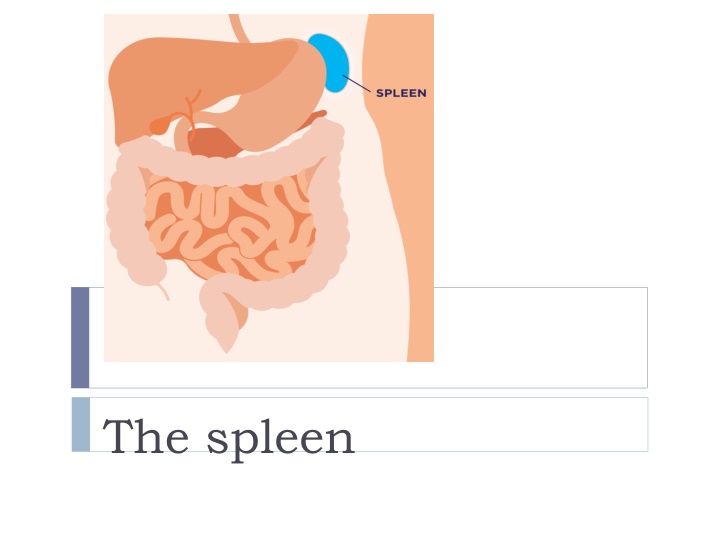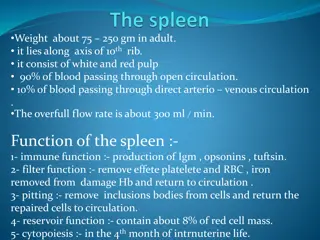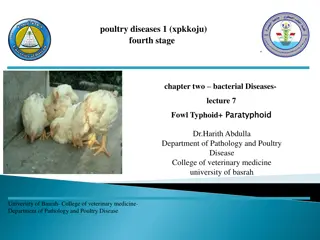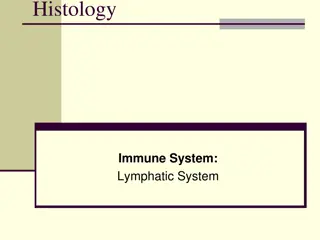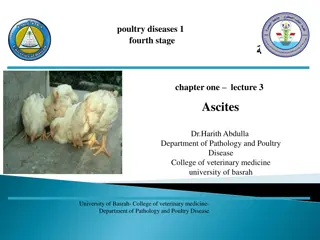The spleen
The spleen is a vital organ in the immune system, responsible for filtering blood, producing lymphocytes, and storing red blood cells. Learn about its structure, functions, and common disorders such as splenic infarction and splenic abscess.
Download Presentation

Please find below an Image/Link to download the presentation.
The content on the website is provided AS IS for your information and personal use only. It may not be sold, licensed, or shared on other websites without obtaining consent from the author.If you encounter any issues during the download, it is possible that the publisher has removed the file from their server.
You are allowed to download the files provided on this website for personal or commercial use, subject to the condition that they are used lawfully. All files are the property of their respective owners.
The content on the website is provided AS IS for your information and personal use only. It may not be sold, licensed, or shared on other websites without obtaining consent from the author.
E N D
Presentation Transcript
The weight of the normal adult spleen is 75250g and it measures up to 10 7 3cm. It lies in the left hypochondrium between the gastric fundus and the left hemidiaphragm. The hilum sits in the angle between the stomach and the kidney and is in contact with the tail of the pancreas. There is a notch on the inferolateral border, and this may be palpated when the spleen is enlarged. The tortuous splenic artery arises from the coeliac axis, usually from a common stem with a hepatic artery, and runs along the upper border of the body and tail of the pancreas, to which it gives small branches. The short gastric and left gastroepiploic branches pass between the layers of the gastrosplenic ligament. The main splenic artery generally divides into superior and inferior branches, which, in turn, subdivide into several segmental branches
The splenic vein is formed from several tributaries that drain the hilum. The vein runs behind the pancreas, receiving several small tributaries from the pancreas before joining the superior mesenteric vein at the neck of the pancreas to form the portal vein. The splenic pulp is invested by an external serous and internal fibroelastic coat which is reflected inwards at the hilum onto the vessels to form vascular sheaths. The lymphatic drainage comprises efferent vessels in the white pulp that run with the arterioles and emerge from nodes at the hilum. These nodes and lymphatics drain via retropancreatic nodes to the coeliac nodes. Sympathetic nerve fibres run from the coeliac plexus and innervate splenic arterial branches.
Functions of the spleen Immune: contains 66.5% and 10 15% of the body s total T and B lymphocyte population, respectively. 2. Filter function: macrophages in the reticulum capture cellular and non-cellular material from the blood and plasma. 3. Pitting: particulate inclusions from red cells are removed, and the repaired red cells are returned to the circulation. 4. Reservoir 5. Cytopoiesis: resulting in the proliferation of T and B cells and macrophages. This myeloproliferative disorders, thalassaemias and chronic haemolytic anaemias. 1. may also occur in
Splenic disorders Splenic infarction This condition commonly occurs in patients with a massively enlarged spleen from myeloproliferative syndrome . Splenic rupture considered in any case of blunt abdominal trauma, particularly when the injury occurs to the left upper quadrant of the abdomen. Splenic abscess Splenic abscess may arise from an infected splenic embolus or in association with typhoid and paratyphoid fever, osteomyelitis, otitis media and puerperal sepsis.
SPLENECTOMY Indications for splenectomy Trauma Accidental Operative Oncological Part of en bloc resection Diagnostic Therapeutic Haematological Spherocytosis Purpura (ITP) Hypersplenism Portal hypertension Variceal surgery 1. 2. 3. 1. 2. 3. 4.
Preoperative preparation In the presence of a coagulopathy, transfusion of blood, fresh-frozen plasma, cryoprecipitate or platelets may be required. Coagulation profiles should be as near normal as possible at operation, and platelets should be available for patients with thrombocytopenia at operation and in the early postoperative period. Antibiotic prophylaxis appropriate to the operative procedure should be given, and consideration should be given to the risk of post-splenectomy sepsis
Notes about Splenectomy Remember preoperative immunization . Prophylactic antibiotics in the long term . Opportunistic post splenectomy infection is a real clinical danger . Splenic conservation should be considered .
